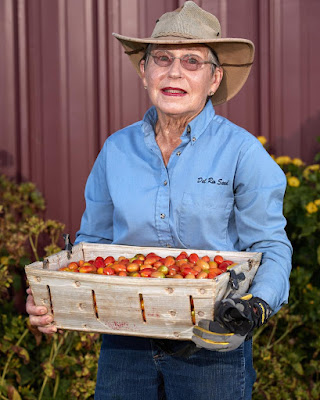
Pioneering farm-to-fork farmer helped popularize heirloom crops

|
|
Suzanne Peabody Ashworth was
instrumental in the growth of Sacramento's
farm-to-fork movement. (Photo courtesy
Del Rio Botanical)
|
Sacramento lost a force of nature with the passing of Suzanne Peabody Ashworth. But many of the rare and heirloom crops that she championed will live on.
Ashworth, who died at age 70 on Dec. 23, grew produce at her West Sacramento farm that was beloved by local chefs and countless diners. Her Del Rio Botanical gourmet organic vegetables became a well-known brand and a cornerstone of Sacramento’s farm-to-fork movement.
A third-generation farmer, Ashworth did a lot more than sell great arugula. She grew more than 1,200 varieties of vegetables, herbs and fruit. Just as important, she kept and shared the seed so others could grow those rarities, too, via the Seed Savers Exchange.
"I've lived here all my life," said Ashworth in a 2009 interview. "I saw the changes, from picking tomatoes by hand to really rock-hard tomatoes that have to withstand being dumped into concrete bins.
"Those changes in the industry affected what's available," she added. "I found myself saying, 'I can't get that anymore.' That's when I got involved with the Seed Savers Exchange. (For example) people could only get three cucumber varieties. But to get others back, you had to save seed. It all ties together."
Ashworth grew varieties rarely seen anywhere else. She filled chefs’ offbeat requests (as well as those from crafters). By preserving the past, she helped secure food’s future.
"I'm not doing anything new," Ashworth explained. "Seed saving used to be something that everybody did. My grandfather did it."
Through the Seed Savers Exchange, Del Rio offered amazing diversity. For example, Ashworth sold seed for 43 varieties of heirloom cherry tomatoes. Her peppers numbered in the hundreds.
Through her seed pursuit, Ashworth became the go-to gourd lady. She sold seed for 75 distinct gourd varieties, a favorite for crafters.
Seed Savers Exchange still offers many of the varieties that Ashworth helped “bring back.” But selling rare seed doesn't necessarily save a species. "We had to create demand," she said. "That's where the restaurants come in."
Ashworth built a demonstration kitchen in her Old River Road home and invited chefs and food pros to dine. Her adjacent dining room sat 20. She cooked what she grew, so she could educate her visitors about the assets of each variety and why these unusual crops were worth celebrating.
"We can get a restaurant's whole staff in here, so they can taste what we're talking about," she said.
Ashworth also developed innovative programs with local chefs such as "Adopt a Squash." Del Rio grew rare squash varieties, including some giants that dated back to the Aztecs. Restaurants adopted and featured those heirloom squash on their menus. The first year, Del Rio sold about 1,000 pounds of adopted squash. The second year, that figure grew to 10,000.
Ashworth also was tremendously generous with other farmers, chefs and women in food. She was among the founding members of the Sacramento chapter of Les Dames d’Escoffier International, the organization devoted to helping women in the food industry.
Alzheimer’s disease stopped this one-woman dynamo way too young. But as she noted, Ashworth planted and grew for the future. Some heirloom varieties still exist thanks to her nurturing.
Besides all her crops, she sowed many seeds of food wisdom including this pearl: Don’t be afraid to grow something different. You might discover a new favorite.
Read Ashworth’s full obituary here: https://www.sacbee.com/news/local/obituaries/article257041087.html
Members of Seed Savers Exchange get free seeds and discounts. Learn more here: https://www.seedsavers.org/ .
Ashworth's 1991 book "Seed to Seed: Seed Saving and Growing Techniques for Vegetable Gardeners" was updated in 2002 and can still be found at used-book sellers online.
Comments
0 comments have been posted.Sacramento Digs Gardening to your inbox.
Sites We Like
Garden Checklist for week of July 21
Your garden needs you!
* Keep your vegetable garden watered, mulched and weeded. Water before 8 a.m. to reduce the chance of fungal infection and to conserve moisture.
* Feed vegetable plants bone meal, rock phosphate or other fertilizers high in phosphate to stimulate more blooms and fruiting. (But wait until daily high temperatures drop out of the 100s.)
* Don’t let tomatoes wilt or dry out completely. Give tomatoes a deep watering two to three times a week.
* Harvest vegetables promptly to encourage plants to produce more. Squash especially tends to grow rapidly in hot weather. Keep an eye on zucchini.
* Pinch back chrysanthemums for bushy plants and more flowers in September.
* Remove spent flowers from roses, daylilies and other bloomers as they finish flowering.
* Pinch off blooms from basil so the plant will grow more leaves.
* Cut back lavender after flowering to promote a second bloom.
* It's not too late to add a splash of color. Plant petunias, snapdragons, zinnias and marigolds.
* From seed, plant corn, pumpkins, radishes, winter squash and sunflowers.